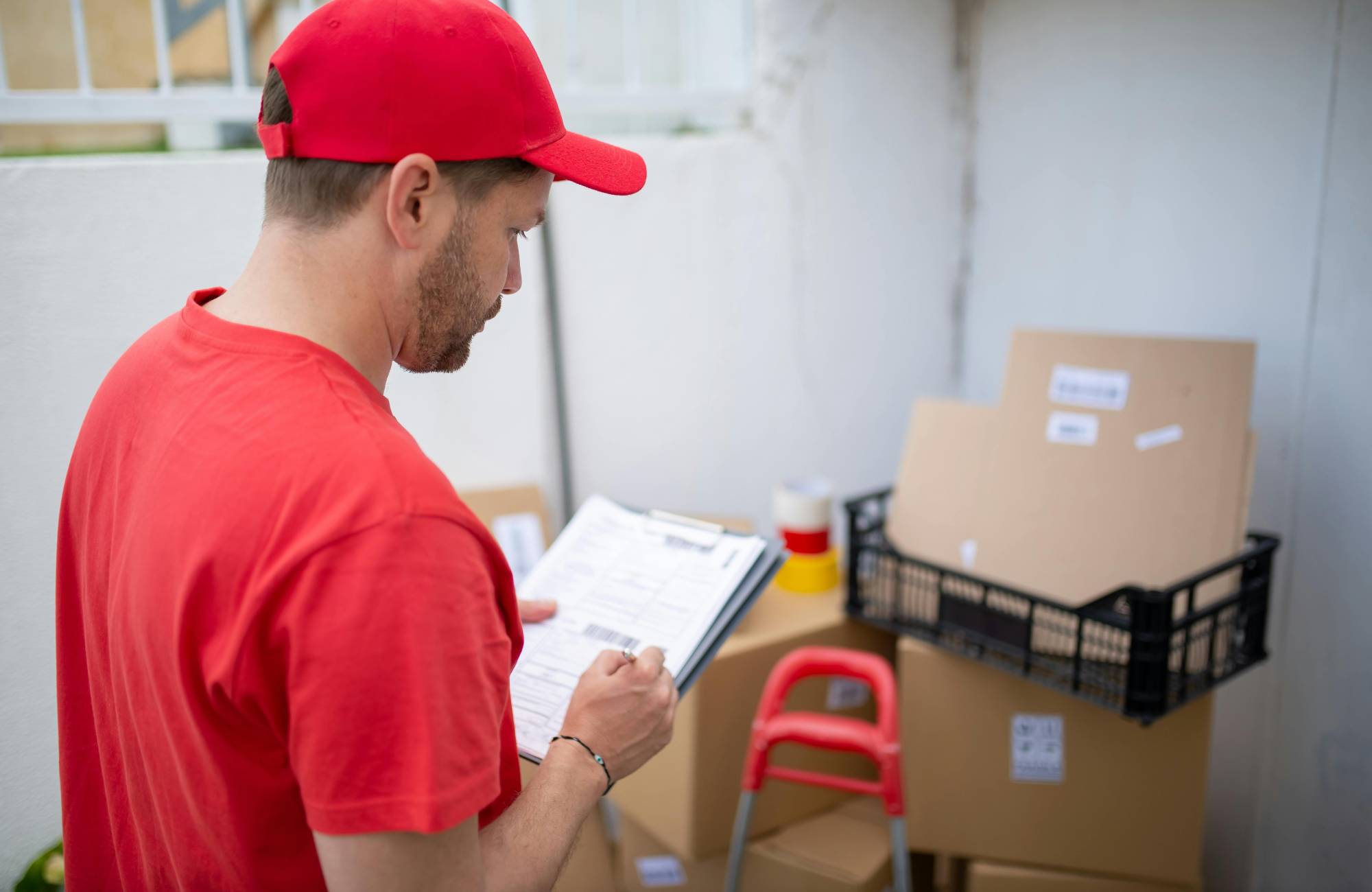In a world where approximately 11 billion tons of goods are transported by sea annually, shipping logistics is crucial in everyday ecommerce operations. And when it comes to shipping, two of the most common options—standard shipping box sizes and flat rate box sizes—are frequently used. Each type carries unique characteristics that can influence cost, flexibility, and practicality.
Here are the 10 most important differences between these two options to help individuals and businesses make smarter shipping decisions.
Table of Contents
Key Takeaways
✔ Flat rate shipping offers fixed pricing, while standard shipping costs vary based on box dimensions, weight, and distance.
✔ Standard boxes can be customized to fit product needs, but flat rate boxes are limited to preset sizes provided by carriers.
✔ Flat rate costs are predictable and consistent, whereas standard shipping expenses can fluctuate depending on several variables.
✔ With flat rate shipping, packaging is included at no extra cost, but standard shipping requires the sender to supply their boxes.
✔ Flat rate boxes have a weight cap (usually 70 lbs), while standard shipping allows more weight but increases the price as weight rises.
✔ Standard shipping provides various speed options like ground, two-day, and overnight, whereas flat rate shipping is tied to fixed services like Priority Mail.
✔ Standard shipping supports a wider range of international destinations and box options, while flat rate international shipping is more limited.
✔ Tracking and basic insurance are included with flat rate services, but they often come as optional add-ons for standard shipping.
✔ Standard shipping can be more environmentally friendly due to better size matching, while flat rate boxes may result in wasted space and packing materials.
✔ Standard shipping is better for oversized, fragile, or custom-branded items, while flat rate works best for small, heavy items shipped long-distance.
![]()
What Are Standard Shipping Boxes?
An estimated 80% of global goods are transported by sea, making maritime shipping the dominant method for international trade. Whether managing an e-commerce operation or sending a personal package, understanding the right box type can make a significant difference.
Standard shipping box sizes are the most common type of packaging used in both personal and commercial shipping. These boxes are not tied to a specific carrier’s program and offer flexibility in materials, dimensions, and use cases.
By using a combination of planning tools like a box sizes chart and reviewing resources such as UPS box sizes and prices, shippers can better control costs while tailoring packaging to individual products.

Planning Tools for Smart Shipping
Proper planning can reduce shipping costs, improve package protection, and streamline logistics. Below are key tools that help businesses and individuals make smart decisions when using standard shipping boxes:
Box Sizes Chart
Most major carriers, such as USPS, UPS, and FedEx, provide box size reference charts. These charts outline suggested dimensions for various product types—like electronics, apparel, or perishables—making it easier to match the product to the correct box size. Using these charts also helps avoid overpacking or underutilizing space, both of which can impact cost and product safety.
UPS Box Sizes and Prices
UPS offers detailed guides listing standard box dimensions alongside corresponding pricing structures. Businesses rely on these resources to compare service levels, anticipate shipping rates, and choose the most cost-effective options. Reviewing these guides also helps when determining whether to use customer-supplied packaging or switch to UPS-provided packaging for flat rate or discounted services.
Online Calculators
Shipping calculators are valuable tools offered by most carriers that estimate shipping costs based on weight, box dimensions, origin, and destination. These calculators also determine whether dimensional weight (DIM weight) applies—important for large but lightweight boxes. With this insight, shippers can decide whether resizing or reconfiguring packaging could lower costs.
Considerations Before Use
While standard shipping boxes offer great versatility, they require thoughtful handling to avoid unnecessary issues or fees. Here are key considerations before putting them into use:
Correct Packing Practices
Proper cushioning, secure sealing, and weight distribution are critical. If items shift during transit due to poor internal packaging, it can lead to damage, increased return rates, or customer dissatisfaction. Trusted moving and storage companies recommend using bubble wrap, air pillows, or packing paper to stabilize contents and fill empty space.
Accurate Measurements
Carriers often apply dimensional weight pricing, which means a light box can still cost more if it’s oversized. Inaccurate box dimensions submitted during label creation can result in billing adjustments or surcharges. Always measure and record length, width, and height accurately—including bulges from overstuffed boxes.
Cost of Materials
Standard boxes are not always free—especially when custom sizes or specialty materials like double-wall corrugation are needed. The cost of the box, plus internal packing materials (e.g., tape, fillers), must be factored into the total shipping expense. Businesses shipping at scale should monitor these inputs as part of their packaging budget.
What Are Flat Rate Shipping Boxes?
Flat rate box sizes are standardized containers provided by shipping carriers like USPS, UPS, and FedEx. These boxes follow a simple rule: if it fits, it ships—for one set price—regardless of weight or distance (within weight limits and service areas).
Predefined Sizes and Easy Matching
One of the biggest advantages of flat rate shipping is the simplicity it offers. With clearly defined box options and predictable pricing, businesses can streamline the packing process and reduce uncertainty.
Box Sizes Chart
Carriers such as USPS and UPS provide detailed charts listing all available flat rate box sizes, including their internal dimensions and pricing tiers. These resources make it easy to quickly match a product to an appropriately sized box. For fulfillment teams, this reduces decision fatigue during busy order cycles and helps standardize packaging processes across the organization.
UPS Box Sizes and Prices
In addition to predefined box sizes, UPS offers pricing guides that help customers compare flat rate options with standard shipping. These guides are especially useful for calculating potential cost savings when shipping heavier items, where flat rate shipping often provides better value. Having this transparency allows shippers to make informed decisions about whether a flat rate box or a traditional box with calculated weight-based pricing is more economical.
Constraints to Keep in Mind
While flat rate boxes offer convenience and cost predictability, they aren’t always the perfect solution for every shipping need. Here are a few key limitations that shippers should evaluate before committing to flat rate packaging:
Not Always Cost-Effective for Lightweight Items
Flat rate pricing is often more beneficial for dense or heavy shipments. For lightweight items that take up little space, using a standard box with calculated shipping based on weight may be significantly cheaper than flat rate options.
No Modifications Allowed
Flat rate boxes must be used as-is. Carriers do not permit alterations such as resizing, cutting, or excessive taping. For brands that want customized unboxing experiences or need to ship unusually shaped products, this rigidity can conflict with branding goals or packaging flexibility.
10 Key Differences Between Standard and Flat Rate Box Sizes
When it comes to shipping, understanding the difference between standard and flat rate box sizes can help you choose the most cost-effective and efficient option for your needs. Whether you’re a small business owner or just mailing packages occasionally, knowing how these two shipping methods differ can save you time and money.
Comparison Table
| Feature | Standard Shipping Box Sizes | Flat Rate Box Sizes |
| Pricing Structure | Variable (weight, size, zone) | Fixed price based on box size |
| Box Flexibility | Unlimited (custom and common box sizes chart options) | Limited to carrier-provided dimensions |
| Cost Predictability | Fluctuates with carrier policies like UPS box sizes and prices | High—easy to estimate shipping costs |
| Packaging Source | Must be purchased or supplied by the sender | Provided free by USPS/UPS/FedEx |
| Weight Limit | No max, but the cost increases with weight | Typically capped at 70 lbs |
| Delivery Speeds | Wide range of speeds available | Usually tied to Priority Mail or equivalent |
| International Use | Widely supported with custom forms | Available, but with limited sizes and pricing tiers |
| Tracking/Insurance | Optional; may cost extra | Included in most cases |
| Environmental Fit | More sustainable due to size options | May result in unused space and excess filler |
| Best For | Irregular, light, or oversized items | Heavy, compact items sent long-distance |
Below are the most critical distinctions between standard shipping box sizes and flat rate box sizes:
1. Pricing Structure
- Standard Shipping: Pricing varies based on a combination of box dimensions, weight, and shipping distance. This makes it less predictable, especially for cross-country or international deliveries. For example, larger boxes with light contents may still incur high fees due to dimensional weight rules.
- Flat Rate Shipping: One flat fee applies regardless of destination or weight (as long as it’s under the maximum allowed). This fixed structure simplifies planning and is often more economical for shipping heavy items over long distances.
2. Box Size Flexibility
- Standard Shipping: Shippers can choose from a wide variety of dimensions or even customize their own packaging. This flexibility is useful for oddly shaped or oversized products. Carriers often provide a box sizes chart to help determine the most efficient size for a shipment.
- Flat Rate Shipping: Only a limited selection of box dimensions is available, such as small, medium, and large. These are predetermined and published by the carrier. Because they cannot be altered, senders must ensure items fit snugly within the provided box size.
3. Cost Predictability
- Flat Rate Shipping: The pricing remains consistent no matter the shipping zone or weight (under the limit), making it easy to forecast expenses. This predictability is especially beneficial for small businesses that want to offer free or flat shipping options at checkout.
- Standard Shipping: Prices fluctuate based on weight, size, and distance, which can make budgeting difficult. Rates may also increase unexpectedly if the box dimensions trigger dimensional weight pricing. Many companies rely on tools like UPS box sizes and prices to estimate and compare costs in advance.
4. Packaging Source
- Standard Shipping: The shipper is responsible for supplying their own packaging. This may involve buying boxes, investing in branded materials, or using custom solutions to meet specific product needs. These additional costs can add up quickly, especially for small-scale shippers.
- Flat Rate Shipping: Carriers provide the packaging free of charge. These boxes are available at local branches or can be ordered online. This convenience helps reduce shipping costs and saves time, especially for individuals or startups with limited resources.
5. Weight Limitations
- Standard Shipping: There is no formal weight limit, but costs increase proportionally with weight. This method is suitable for lightweight or medium-weight items that don’t benefit from flat pricing. However, shippers must watch for dimensional weight charges, which can apply even to low-weight items in large boxes.
- Flat Rate Shipping: A maximum weight—usually 70 lbs for USPS—applies across all flat rate boxes. As long as the package stays under that limit and fits within the box dimensions, the cost remains the same. This makes flat rate ideal for shipping compact, heavy items that would be expensive to send through standard pricing.
6. Delivery Speed Options
- Standard Shipping: Offers a wide range of delivery speeds depending on the carrier and service level. Options typically include ground shipping, two-day delivery, next-day air, and even same-day services in some regions. This flexibility allows shippers to prioritize either cost or urgency depending on the situation.
- Flat Rate Shipping: Usually tied to a fixed delivery class, such as USPS Priority Mail or UPS Simple Rate. These services generally deliver within 1–3 business days, but offer fewer options for speed customization. While reliable, they may not meet the needs of customers requiring guaranteed overnight or time-definite delivery.
7. International Shipping
- Standard Shipping: Supports international delivery to most countries, provided the shipper meets customs and documentation requirements. Carriers often include international rates and dimensions in their box sizes chart, allowing businesses to prepare appropriate packaging for global destinations.
- Flat Rate Shipping: Available for international use but limited to select countries and regions. Carriers like USPS offer international flat rate boxes with fixed pricing, but the available flat rate box sizes are fewer than those offered for domestic shipping. This can be restrictive for items that don’t fit well within the available box dimensions.
8. Tracking and Insurance
- Flat Rate Shipping: Typically includes door-to-door tracking and base-level insurance coverage at no additional cost. Most carriers offer $50–$100 of insurance automatically, which is sufficient for many consumer goods and e-commerce items. These features are built into the service, offering convenience and peace of mind.
- Standard Shipping: Tracking and insurance are not always included and often need to be added manually during checkout or order fulfillment. While this allows for more customization, it also adds complexity and cost. Businesses must weigh the value of these add-ons against the total shipping expense.
9. Environmental Impact
- Standard Shipping: Allows shippers to use appropriately sized packaging that closely fits the product. This reduces the need for excess void fill like bubble wrap or foam and results in less waste. Environmentally conscious companies often prefer standard shipping for its potential to reduce materials and shipping volume.
- Flat Rate Shipping: Uses predetermined box sizes that may not align well with the actual size of the item being shipped. This mismatch can lead to overpacking or the use of additional fillers, which increases material waste. While convenient, it may not be the most sustainable option, especially for eco-focused businesses.
10. Best Use Cases
- Standard Shipping: Ideal for items that are large, irregularly shaped, lightweight, or fragile. It’s also a better choice for shipments that require branded packaging or special handling. Customization and flexibility make standard shipping a go-to for businesses with diverse product lines.
- Flat Rate Shipping: Best suited for small, dense, heavy items that would otherwise be expensive to ship based on weight. Products like tools, books, small electronics, or canned goods fit well within the flat rate box sizes and offer excellent value, especially for cross-country or multi-zone shipping.
Frequently Asked Questions
Standard shipping box sizes are packaging options that vary in dimensions and materials, not tied to a specific pricing model. These boxes are priced based on size, weight, and shipping distance. Shippers can use a box sizes chart from carriers like UPS to choose the right size for their needs.
Flat rate shipping typically takes 1 to 3 business days for domestic deliveries within the U.S. This service is often tied to USPS Priority Mail or similar options from other carriers. Delivery times may vary slightly depending on origin and destination.
Yes, you can use your own box for USPS, but it will be priced based on standard shipping rates, not flat rate. To use flat rate pricing, you must use USPS-provided flat rate boxes. Make sure your own box meets USPS packaging and labeling requirements.
It depends on the package’s weight, size, and destination. Flat rate boxes are often cheaper for heavy items going long distances. For lightweight or short-distance shipments, your own box may cost less using standard shipping.
Flat rate shipping charges a fixed price based on box size, regardless of weight or distance (within limits). Standard shipping costs vary depending on the box’s dimensions, total weight, and how far it’s traveling. Flat rate offers simplicity; standard offers flexibility.

Get the Right Shipping Solution with Warehouse Logistics By Best
Whether you’re navigating standard shipping box sizes or deciding between flat rate and custom packaging, expert guidance can save you time and money. That’s why Warehouse Logistics By Best is the trusted partner for businesses and individuals in New York, NY, looking to streamline fulfillment and reduce shipping costs.
With flexible storage options, professional packing services, and cost-efficient logistics, Warehouse Logistics By Best helps you ship smarter—no matter the size or destination. If you’re based in New York, NY, and need reliable warehousing or shipping support, our experienced team is ready to help.
Choose Warehouse Logistics By Best to simplify your shipping process and keep your supply chain moving!


